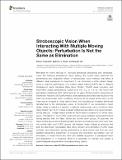Files in this item
Stroboscopic vision when interacting with multiple moving objects : perturbation is not the same as elimination
Item metadata
| dc.contributor.author | Bennett, Simon J. | |
| dc.contributor.author | Hayes, Spencer J. | |
| dc.contributor.author | Uji, Makoto | |
| dc.date.accessioned | 2018-07-25T08:30:05Z | |
| dc.date.available | 2018-07-25T08:30:05Z | |
| dc.date.issued | 2018-07-25 | |
| dc.identifier | 254055784 | |
| dc.identifier | 019ce20c-312a-4786-b7e3-e045aa99a850 | |
| dc.identifier | 85050458636 | |
| dc.identifier | 000439833700002 | |
| dc.identifier.citation | Bennett , S J , Hayes , S J & Uji , M 2018 , ' Stroboscopic vision when interacting with multiple moving objects : perturbation is not the same as elimination ' , Frontiers in Psychology , vol. 9 , 1290 . https://doi.org/10.3389/fpsyg.2018.01290 | en |
| dc.identifier.issn | 1664-1078 | |
| dc.identifier.other | ORCID: /0000-0002-9445-6353/work/46939709 | |
| dc.identifier.uri | https://hdl.handle.net/10023/15703 | |
| dc.description | This study was supported in part by the Biotechnology and Biological Sciences Research Council (Grant Reference BB/J018872/1). | en |
| dc.description.abstract | Motivated by recent findings of improved perceptual processing and perceptual-motor skill following stroboscopic vision training, the current study examined the performance and acquisition effects of stroboscopic vision methods that afford a different visual experience. In Experiment 1, we conducted a within-subject design study to examine performance of a multiple object tracking (MOT) task in different stroboscopic vision conditions (Nike Vapor Strobe®, PLATO visual occlusion, intermittent display presentation) operating at 5.6, 3.2 or 1.8Hz. We found that participants maintained MOT performance in the Vapor Strobe condition irrespective of strobe rate. However, MOT performance deteriorated as strobe rate was reduced in the other two stroboscopic vision conditions. Moreover, at the lowest strobe rate (1.8Hz) there was an increase in probe reaction time, thus indicating an increased attentional demand due to the stroboscopic vision. In Experiment 2, we conducted a mixed design study to examine if practice in different stroboscopic vision conditions (Nike Vapor Strobe®, PLATO visual occlusion) influenced acquisition of a novel precision-aiming task (i.e., multiple object avoidance (MOA) task) compared to a normal vision group. Participants in the PLATO visual occlusion group exhibited worse performance during practice than the Vapor Strobe and normal vision groups. At post-test, the Vapor Strobe group demonstrated greater success and reduced end-point error than the normal vision and PLATO groups. We interpret these findings as showing that both an intermittent perturbation (Nike Vapor Strobe®) and elimination (PLATO visual occlusion, intermittent display presentation) of visual motion and form are more attention demanding (Experiment 1), however the intermittent perturbation, but not elimination, of visual motion and form can facilitate acquisition of perceptual-motor skill (Experiment 2) in situations where it is necessary to maintain and update a spatio-temporal representation of multiple moving objects. | |
| dc.format.extent | 13 | |
| dc.format.extent | 1305055 | |
| dc.language.iso | eng | |
| dc.relation.ispartof | Frontiers in Psychology | en |
| dc.subject | Stroboscopic vision | en |
| dc.subject | MOT | en |
| dc.subject | MOA | en |
| dc.subject | Perceptual-motor | en |
| dc.subject | Motion | en |
| dc.subject | Form | en |
| dc.subject | BF Psychology | en |
| dc.subject | NDAS | en |
| dc.subject.lcc | BF | en |
| dc.title | Stroboscopic vision when interacting with multiple moving objects : perturbation is not the same as elimination | en |
| dc.type | Journal article | en |
| dc.contributor.institution | University of St Andrews. School of Psychology and Neuroscience | en |
| dc.identifier.doi | https://doi.org/10.3389/fpsyg.2018.01290 | |
| dc.description.status | Peer reviewed | en |
| dc.identifier.url | https://www.frontiersin.org/articles/10.3389/fpsyg.2018.01290/abstract | en |
This item appears in the following Collection(s)
Items in the St Andrews Research Repository are protected by copyright, with all rights reserved, unless otherwise indicated.

